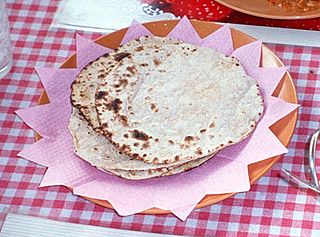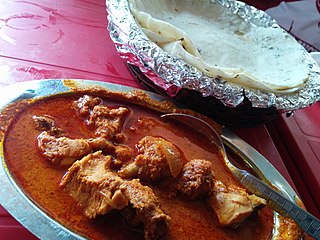
Blood sausages are sausages filled with blood that is cooked or dried and mixed with a filler until it is thick enough to solidify when cooled. Variants are found worldwide. Pig, cow, horse, donkey, sheep, duck, and goat blood can be used, varying by country. Black pudding is the distinct regional type of blood sausage originating in the United Kingdom and Ireland.

Roti is a round flatbread native to the Indian subcontinent made from stoneground wholemeal flour, traditionally known as gehu ka atta, and water that is combined into a dough. Roti is consumed in many countries worldwide. Its defining characteristic is that it is unleavened. Naan from the Indian subcontinent, by contrast, is a yeast-leavened bread, as is kulcha. Like breads around the world, roti is a staple accompaniment to other foods.

Trinidad and Tobago cuisine is the cuisine of the Caribbean island state of Trinidad and Tobago. It reflects a fusion of African, Creole, Indian-South Asian, Chinese, Amerindian, Arab, European, and Latin American-Spanish-Portuguese cuisines.

Callaloo is a popular Caribbean vegetable dish. There are many variants across the Caribbean, depending on the availability of local vegetables. The main ingredient is an indigenous leaf vegetable, traditionally either amaranth, taro or Xanthosoma.

Burmese cuisine is mainly an amalgam of cuisines from various regions of Myanmar. It has also been influenced by various cuisines of neighbouring countries, in particular, China, India and Thailand.

Iraqi cuisine or Mesopotamian cuisine has its origins from Sumerians, Akkadians, Babylonians, Assyrians, ancient Persians, Mesopotamian Arabs, and the other ethnic groups of the region. Tablets found in ancient ruins in Iraq show recipes prepared in the temples during religious festivals – the first cookbooks in the world. Ancient Iraq, or Mesopotamia, was home to a sophisticated and highly advanced civilization, in all fields of knowledge, including the culinary arts. However, it was in the Islamic Golden Age when Baghdad was the capital of the Abbasid Caliphate (750–1258) that the Iraqi kitchen reached its zenith. Today, the cuisine of Iraq reflects this rich inheritance as well as strong influences from the culinary traditions of neighbouring Iran, Turkey, and the Syria region area.
The Culture of Saint Lucia blends the influences of African, French, and English heritage. The official language of the island is English but Kreole, a form of French patois, remains an influential secondary language. The people are predominantly Catholic but the religious climate is tolerant.

Kofta is a family of meatball or meatloaf dishes found in the Indian subcontinent, South Caucasian, Middle Eastern, Balkan, and Central Asian cuisines. In the simplest form, koftas consist of balls of ground meat - usually beef, chicken, lamb or mutton, pork, or a mixture - mixed with spices or onions. In Muslim cultures, pork is not commonly used. In many areas in India, beef is not commonly used. In Greece and Cyprus, vegetarian versions are known as hortokeftedes, and often eaten during fasting periods such as Lent. An uncooked version is also made in Turkey, called çiğ köfte. In India, vegetarian varieties may use potato, calabash, paneer, or banana. In Europe, kofta is often served in a fast-food sandwich in kebab shops.

Levantine cuisine is the traditional cuisine of the Levant, known in Arabic as the Bilad al-Sham and Mashriq, which covers a large area of the Eastern Mediterranean. It continues to carry an influentially mainstream character in a majority of the dishes today. It is found in the modern states of Cyprus, Jordan, Lebanon, Israel, Palestine, Syria, and parts of southern Turkey near Adana, Gaziantep, and Antakya. Conversely, some of the dishes listed below may have early origins in neighboring regions, but have long since become traditions in the Levant.

Uzbek cuisine shares the culinary traditions of Turkic peoples across Central Asia. There is a great deal of grain farming in Uzbekistan, so breads and noodles are of importance, and Uzbek cuisine has been characterized as "noodle-rich". Mutton is a popular variety of meat due to the abundance of sheep in the country and it is a part of various Uzbek dishes.

Afghan cuisine is largely based upon the nation's chief crops, such as wheat, maize, barley and rice. Accompanying these staples are native fruits and vegetables and dairy products such as milk, yogurt, and whey. The nation's culinary specialties reflect its ethnic and geographic diversity. Afghanistan is known for its high-quality pomegranates, grapes, and sweet, rugby-football shaped melons. The national dish of Afghanistan is Kabuli palaw.

Chicken curry is a dish originating from the Indian subcontinent. It is common in the Indian subcontinent, Southeast Asia, and Great Britain, as well as in the Caribbean. A typical curry from the Indian subcontinent consists of chicken stewed in an onion- and tomato-based sauce, flavoured with ginger, garlic, tomato puree, chilli peppers and a variety of spices, often including turmeric, cumin, coriander, cinnamon, and cardamom. Outside South Asia, curry chicken is often made with a pre-made spice mixture known as curry powder.

Tunisian cuisine, the cuisine of Tunisia, is a blend of Mediterranean and Berber cuisines. Its distinctive spiciness comes from the many civilizations which have ruled the land now known as Tunisia: Romans, Vandals, Byzantines, Arabs, Spanish, Turkish, Italians (Sicilians), French, and the native Punics-Berber people. Many of the cooking styles and utensils began to take shape when the ancient tribes were nomads. Nomadic people were limited in their cooking implements by what pots and pans they could carry with them. The Tunisian tagine, is very different from the Algerian or Moroccan dish. It is a type of a pie dish, made out of eggs, meat and vegetables, similar to the Italian frittata or the eggah.
Belizean cuisine is an amalgamation of all ethnicities in the nation of Belize and their respectively wide variety of foods. Breakfast often consists of sides of bread, flour tortillas, or fry jacks that are often homemade and eaten with various cheeses. All are often accompanied with refried beans, cheeses, and various forms of eggs, etc. Inclusive is also cereal along with milk, coffee, or tea.

Street foods, ready-to-eat food or drink sold in a street or other public place, such as a market or fair, by a hawker or vendor, often from a portable stall, have variations within both regions and cultures. For example, Dorling Kindersley describes the street food of Viet Nam as being "fresh and lighter than many of the cuisines in the area" and "draw[ing] heavily on herbs, chile peppers and lime," while street food of Thailand is "fiery" and "pungent with shrimp paste... and fish sauce" with New York City's signature street food being the hot dog, although the offerings in New York also range from "spicy Middle Eastern falafel or Jamaican jerk chicken to Belgian waffles." In Hawaii, the local street food tradition of "Plate Lunch" was inspired by the bento of the Japanese who had been brought to Hawaii as plantation workers.

Malaysian Indian cuisine, or the cooking of the ethnic Indian communities in Malaysia consists of adaptations of authentic dishes from India, as well as original creations inspired by the diverse food culture of Malaysia. Because the vast majority of Malaysia's Indian community are of South Indian descent, and are mostly ethnic Tamils who are descendants of immigrants from a historical region which consists of the modern Indian state of Tamil Nadu and Sri Lanka's Northern Province, much of Malaysian Indian cuisine is predominantly South Indian inspired in character and taste. A typical Malaysian Indian dish is likely to be redolent with curry leaves, whole and powdered spice, and contains fresh coconut in various forms. Ghee is still widely used for cooking, although vegetable oils and refined palm oils are now commonplace in home kitchens. Before a meal it is customary to wash hands as cutlery is often not used while eating, with the exception of a serving spoon for each respective dish.

Buljol is a salad dish of the cuisine of Trinidad and Tobago. It consists of chopped codfish, tomatoes and chilies. The name is of French origin. 18th century colonial power Spain launched the cédula de población in 1783, an edict that successfully promoted the settling of French planters in Trinidad who quickly set the population majority. The name is a combination of the French words brulé (burnt) and gueule (muzzle), which was changed into "bu'n jaw" in Trinidad's 19th century patois and finally morphed into "buljol". The name does not relate to the temperature of the dish but to its hotness, caused by the added hot pepper.

Kuchela, also spelled kucheela, occasionally also kuchila, is a hot relish of the Trinidadian cuisine.

Pelau is a traditional rice dish of the French West Indies and popularized in other islands such as Trinidad and Tobago, Grenada and Saint Vincent and the Grenadines. Main ingredients are meat (usually chicken or beef, rice, pigeon peas or cowpeas, coconut milk and sugar; various vegetables and spices are optional ingredients. Spices used in the dish include cardamom, cloves, cumin and coriander. The meat is caramelised and the other ingredients are then added one by one, resulting in a dark brown stew.

Arab Indonesian cuisine is characterized by the mixture of Middle Eastern cuisine with local Indonesian-style. Arab Indonesians brought their legacy of Arab cuisine—originally from Hadhramaut, Hejaz and Egypt—and modified some of the dishes with the addition of Indonesian ingredients. The Arabs arrived in the Nusantara archipelago to trading and spread Islam. In Java, since the 18th century AD, most of Arab traders settled on the north coast and diffuse with indigenous, thus affecting the local cuisine culture, especially in the use of mutton meat and ghee in cooking.





















